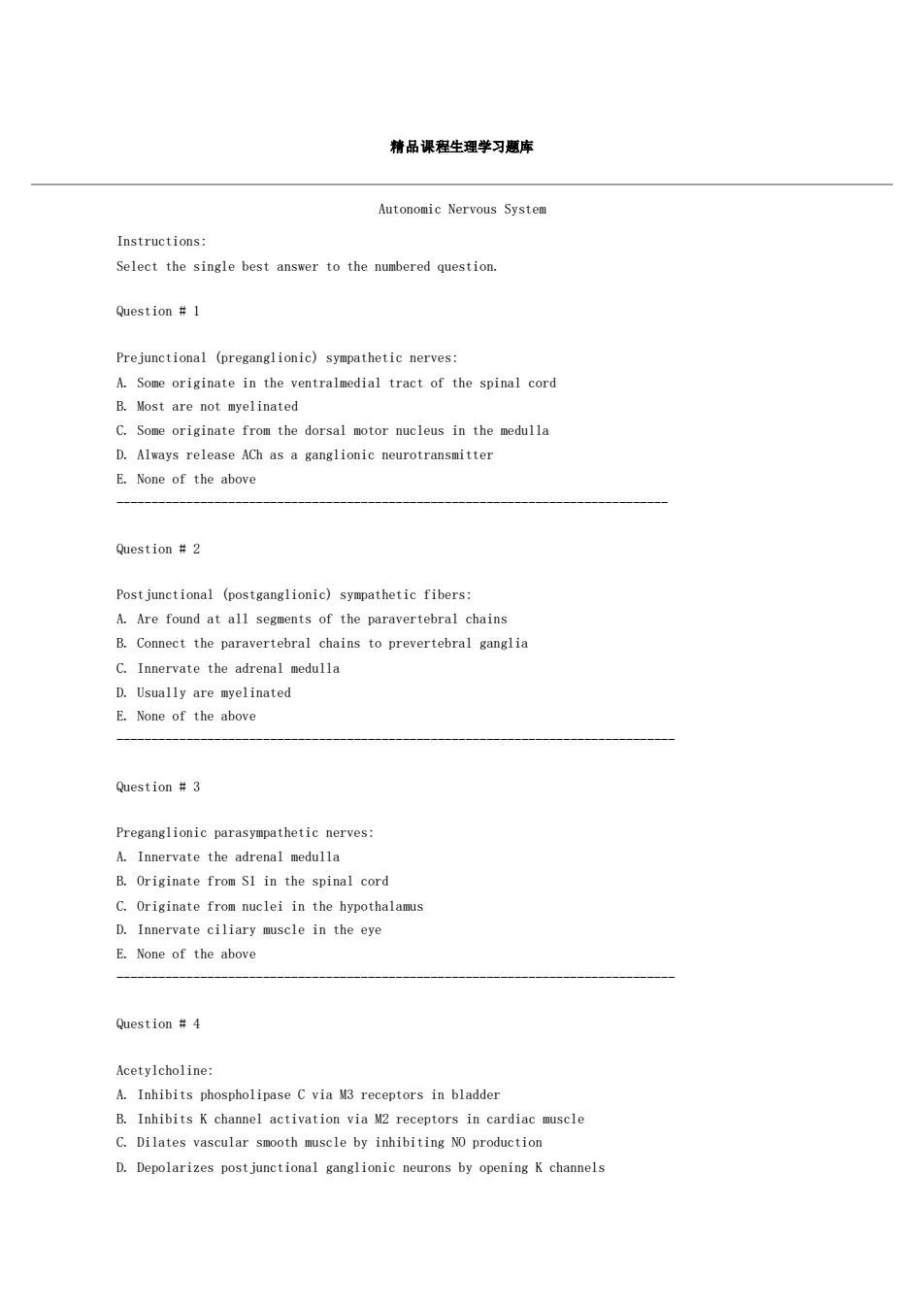
精品课程生理学习题库 Autonomic Nervous System Instructions: Select the single best answer to the numbered question. Question #1 Prejunctional (preganglionic)sympathetic nerves: A Some originate in the ventralmedial tract of the spinal cord B Most elinated C.Some originate from the dorsal oto nucleus in thedul D.Always release ACh as a ganglionic neurotransmitter E.None of the above Question #2 Post junctional (postganglionic)sypathetic fibers A.Are found at all segaents of the paravertebral chains B.Connect the paravertebral chains to prevertebral ganglia C.Innervate the adrenal medulla D.Usually are nvelinated E None of the above Question#3 Preganglionic parasympathetic nerves: A.Innervate the adrenal medulla B.Originate from 51 in the spinal cord D.Innervate ciliary muscle in the eye E.None of the above Question #4 .Inhibits phospholipase C via M3 receptors in bladder B.Inhibits K channel activation via M2 receptors in cardiac muscle C.Dilates vascular smooth muscle by inhibiting NO production D.Depolarizes post junctional ganglionic neurons by opening K channels
精品课程生理学习题库 Autonomic Nervous System Instructions: Select the single best answer to the numbered question. Question # 1 Prejunctional (preganglionic) sympathetic nerves: A. Some originate in the ventralmedial tract of the spinal cord B. Most are not myelinated C. Some originate from the dorsal motor nucleus in the medulla D. Always release ACh as a ganglionic neurotransmitter E. None of the above ------------------------------------------------------------------------------- Question # 2 Postjunctional (postganglionic) sympathetic fibers: A. Are found at all segments of the paravertebral chains B. Connect the paravertebral chains to prevertebral ganglia C. Innervate the adrenal medulla D. Usually are myelinated E. None of the above -------------------------------------------------------------------------------- Question # 3 Preganglionic parasympathetic nerves: A. Innervate the adrenal medulla B. Originate from S1 in the spinal cord C. Originate from nuclei in the hypothalamus D. Innervate ciliary muscle in the eye E. None of the above -------------------------------------------------------------------------------- Question # 4 Acetylcholine: A. Inhibits phospholipase C via M3 receptors in bladder B. Inhibits K channel activation via M2 receptors in cardiac muscle C. Dilates vascular smooth muscle by inhibiting NO production D. Depolarizes postjunctional ganglionic neurons by opening K channels
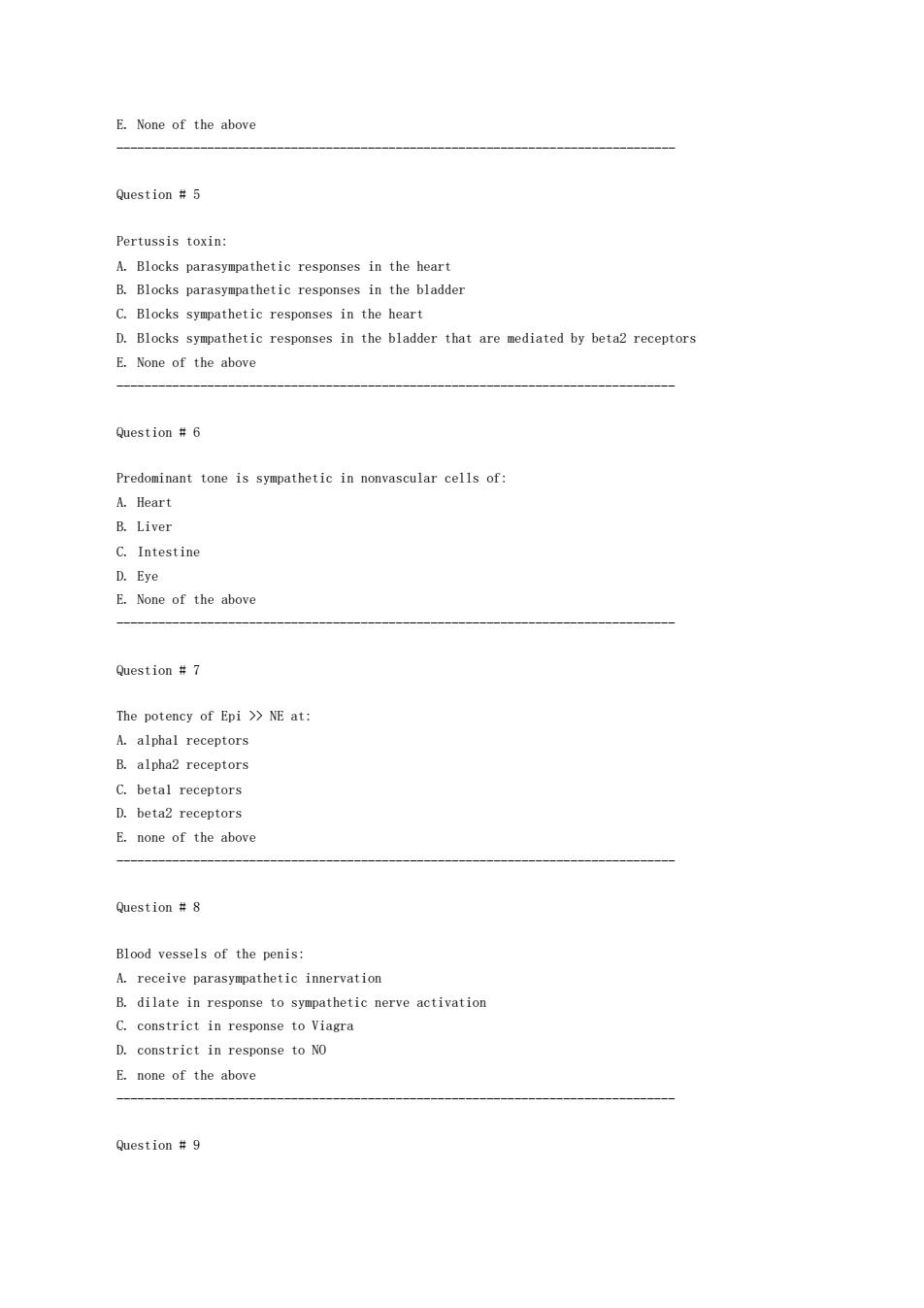
E.None of the above Pertussis toxin: A Blocks parasympathetic responses in the heart B.Blocks parasympathetic responses in the bladder C.Blocks syapathetic responses in the heart D.Blocks syapathetic responses in the bladder that are mediated by beta2 receptor E.None of the above Question#6 Predominant tone is sympathetic in nonvascular cells of: A.Heart B.Liver C.Intestine D.Eye E None of the above Question#7 The potency of Epi》Eat A.alphal receptors B.alpha2 receptors C.betal receptors D heta?recentors E none of the above Question#8 Blood vessels of the penis: A receive parasympathetic innervation D.constrict in response to NO E.none of the above Question #9
E. None of the above -------------------------------------------------------------------------------- Question # 5 Pertussis toxin: A. Blocks parasympathetic responses in the heart B. Blocks parasympathetic responses in the bladder C. Blocks sympathetic responses in the heart D. Blocks sympathetic responses in the bladder that are mediated by beta2 receptors E. None of the above -------------------------------------------------------------------------------- Question # 6 Predominant tone is sympathetic in nonvascular cells of: A. Heart B. Liver C. Intestine D. Eye E. None of the above -------------------------------------------------------------------------------- Question # 7 The potency of Epi >> NE at: A. alpha1 receptors B. alpha2 receptors C. beta1 receptors D. beta2 receptors E. none of the above -------------------------------------------------------------------------------- Question # 8 Blood vessels of the penis: A. receive parasympathetic innervation B. dilate in response to sympathetic nerve activation C. constrict in response to Viagra D. constrict in response to NO E. none of the above -------------------------------------------------------------------------------- Question # 9
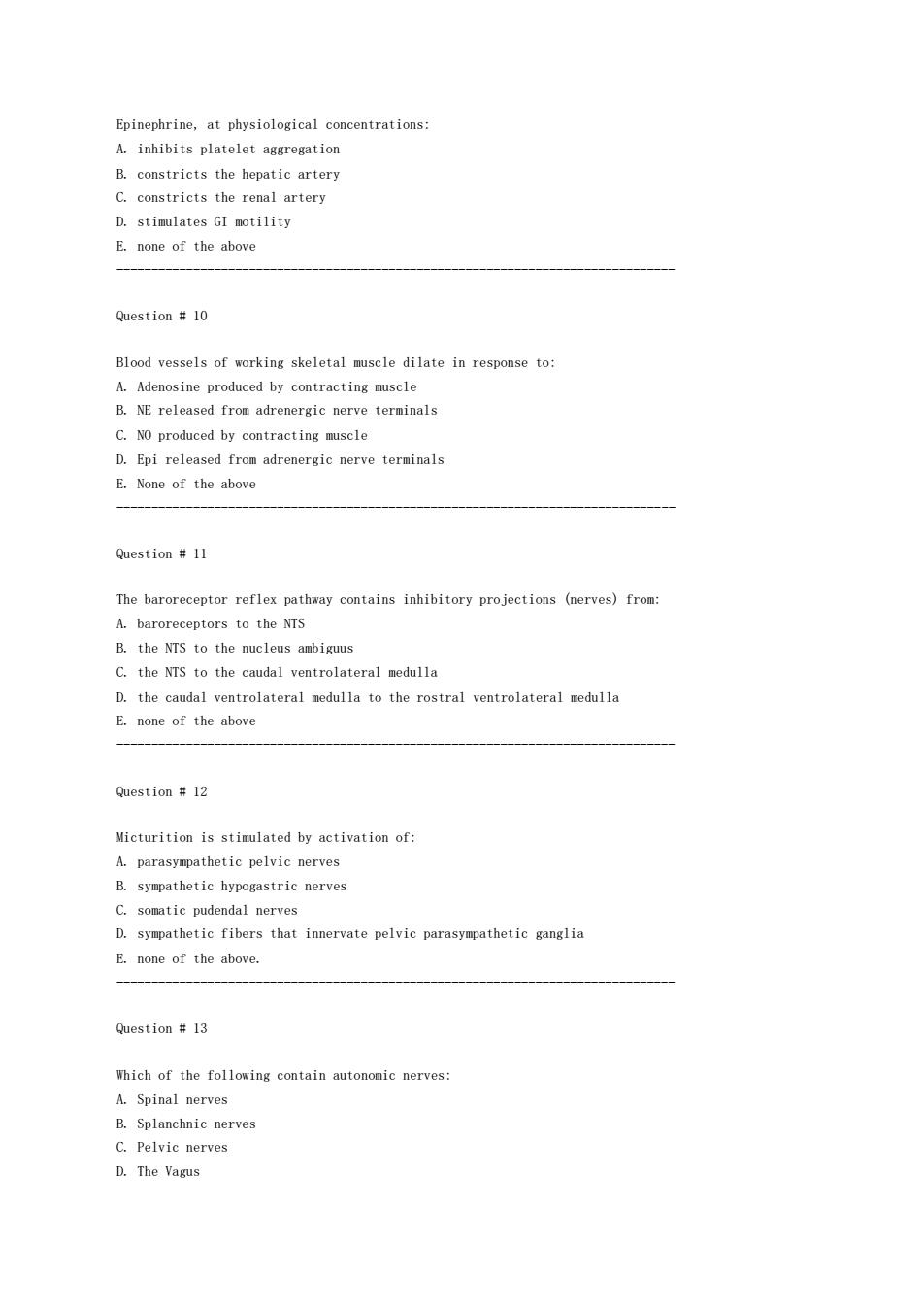
Epinephrine,at physiological concentrations: A inhibits platelet aggregation Iartery D.stimulates GI motility E.none of the above Question #10 Blood vessels of orking skeletal scle dilate in response to A.Adenosine produced by contracting muscle B.NE released from adrenergic nerve terminals C.NO produced by contracting muscle D.Epi released from adrenergic nerve terminals E.None of the above Question 11 The baroreceptor reflex pathway contains inhibitory projections (nerves)from: A baroreceptors to the NTS B.the NTS to the nucleus ambiguus C.the NTS to the caudal ventrolateral edulla D.the caudal ventrolateral medulla to the rostral ventrolateral medulla E.none of the above Question 12 Micturition is stimlated by activation of: nerves B.sympathetic hypogastric nerves C.somatic pudendal nerves D.sympathetic fibers that innervate pelvic parasympathetic ganglia E.none of the above. Question#13 Which of the following contain autonomic nerves A Spinal nerves B.Splanchnic nerves C.Pelvic nerves D.The Vagus
Epinephrine, at physiological concentrations: A. inhibits platelet aggregation B. constricts the hepatic artery C. constricts the renal artery D. stimulates GI motility E. none of the above -------------------------------------------------------------------------------- Question # 10 Blood vessels of working skeletal muscle dilate in response to: A. Adenosine produced by contracting muscle B. NE released from adrenergic nerve terminals C. NO produced by contracting muscle D. Epi released from adrenergic nerve terminals E. None of the above -------------------------------------------------------------------------------- Question # 11 The baroreceptor reflex pathway contains inhibitory projections (nerves) from: A. baroreceptors to the NTS B. the NTS to the nucleus ambiguus C. the NTS to the caudal ventrolateral medulla D. the caudal ventrolateral medulla to the rostral ventrolateral medulla E. none of the above -------------------------------------------------------------------------------- Question # 12 Micturition is stimulated by activation of: A. parasympathetic pelvic nerves B. sympathetic hypogastric nerves C. somatic pudendal nerves D. sympathetic fibers that innervate pelvic parasympathetic ganglia E. none of the above. -------------------------------------------------------------------------------- Question # 13 Which of the following contain autonomic nerves: A. Spinal nerves B. Splanchnic nerves C. Pelvic nerves D. The Vagus
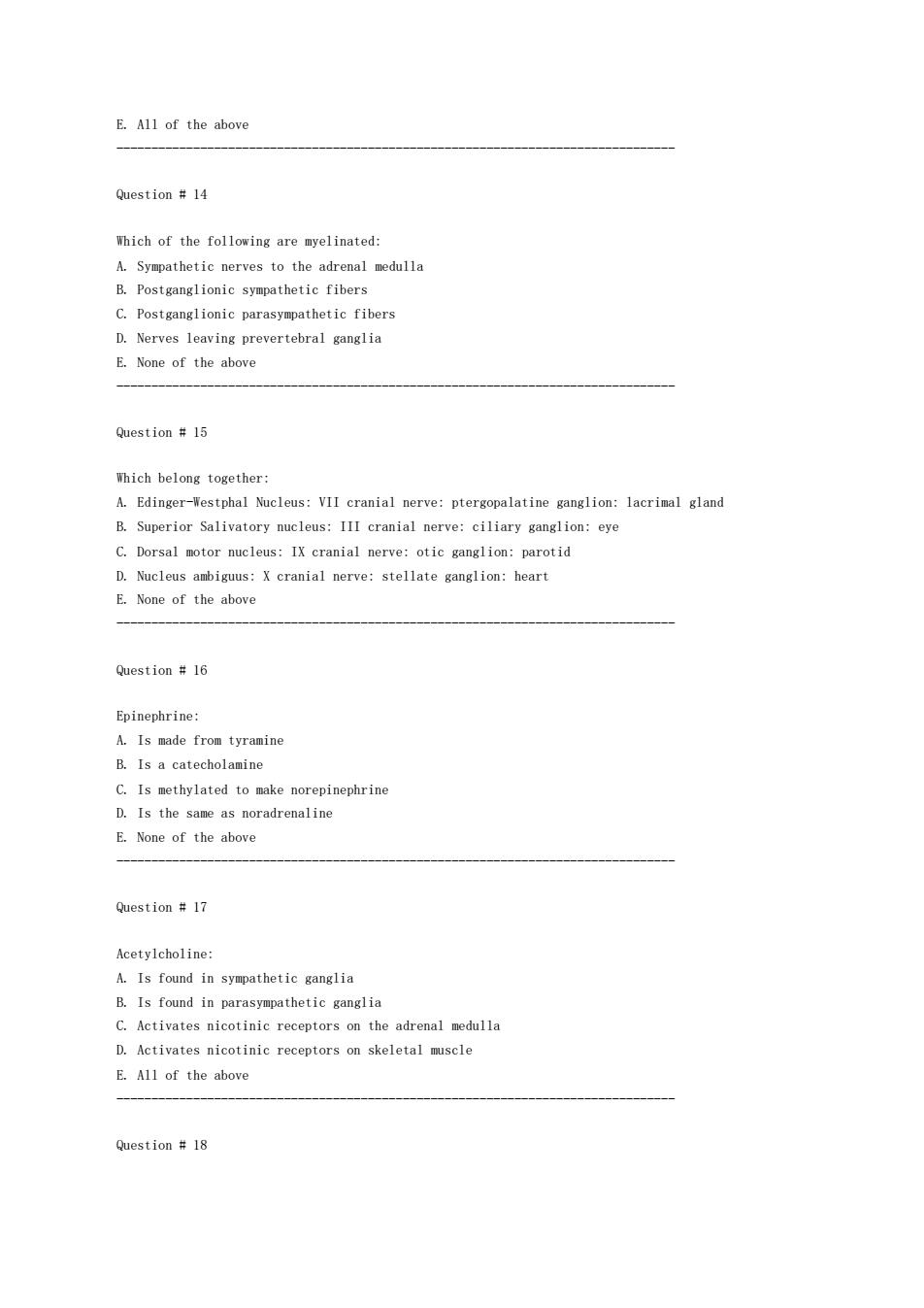
E All of the above Which of the folloing are myelinated: A.Sympathetic nerves to the adrenal medulla B.Postganglionic sympathetic fibers C.Postganglionic parasyupathetic fibers D.Nerves leaving prevertebral ganglia E.None of the above Question#15 Which belong together: A.Edinger-Westphal Nucleus:VII cranial perve:ptergopalatine ganglion:lacrimal gland B Superior Salivatory nucleus:III cranial nerve:ciliary ganglion:eye Dorsal motor nucleus:IX cranial nerve:otic ganglion:parotid D.Nucleus ambiguus:X cranial nerve:stellate ganglion:heart E.None of the above Question #16 A Is made from tyramine B.Is a catecholamine C.Is methylated to make norepinephrine D.Is the same as noradrenaline E None of the above Question#17 Acetylcholine: A.Is found in sympathetic ganglia D.Activates nicotinic receptors on skeletal scle E.All of the above Question 18
E. All of the above -------------------------------------------------------------------------------- Question # 14 Which of the following are myelinated: A. Sympathetic nerves to the adrenal medulla B. Postganglionic sympathetic fibers C. Postganglionic parasympathetic fibers D. Nerves leaving prevertebral ganglia E. None of the above -------------------------------------------------------------------------------- Question # 15 Which belong together: A. Edinger-Westphal Nucleus: VII cranial nerve: ptergopalatine ganglion: lacrimal gland B. Superior Salivatory nucleus: III cranial nerve: ciliary ganglion: eye C. Dorsal motor nucleus: IX cranial nerve: otic ganglion: parotid D. Nucleus ambiguus: X cranial nerve: stellate ganglion: heart E. None of the above -------------------------------------------------------------------------------- Question # 16 Epinephrine: A. Is made from tyramine B. Is a catecholamine C. Is methylated to make norepinephrine D. Is the same as noradrenaline E. None of the above -------------------------------------------------------------------------------- Question # 17 Acetylcholine: A. Is found in sympathetic ganglia B. Is found in parasympathetic ganglia C. Activates nicotinic receptors on the adrenal medulla D. Activates nicotinic receptors on skeletal muscle E. All of the above -------------------------------------------------------------------------------- Question # 18
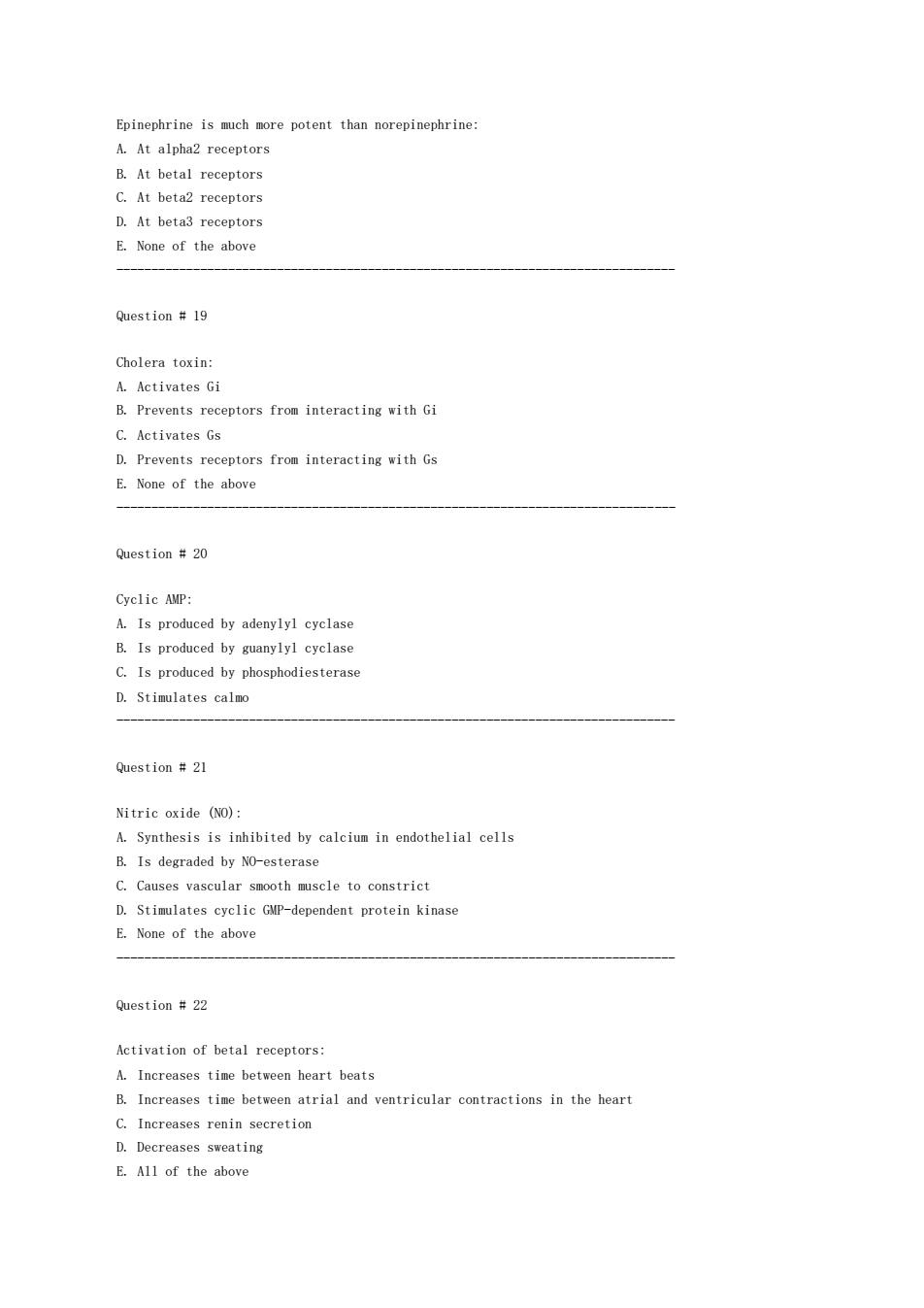
Epinephrine is nuch more potent than norepinephrine: A.At alpha2 receptors B.At betal reeptors C.At beta2 receptors D.At beta3 receptors E.None of the above Question#19 Cholera toxin A.Activates Gi B.Prevents receptors from interacting with Gi C Activates Gs D.Prevents receptors from interacting with Gs E None of the above Question 20 Cyclic AMP A Is produced by adenvlyl cyclase B.Is produced by guanvlvl cvclase C.Is produced by phosphodiesterase D.Stimulates calmo Question 21 Nitric oxide (NO): A.Synthesis is inhibited by calcium in endothelial cells B.Is degraded d by No-esteras Causes vascular smooth muscle to constrict D.Stimulates cyclic GNP-dependent protein kinase E.None of the above Activation of betal receptors A.Increases tine between heart beats B.Increases time between atrial and ventricular contractions in the heart C.Increases renin secretion D.Decreases sweating E All of the above
Epinephrine is much more potent than norepinephrine: A. At alpha2 receptors B. At beta1 receptors C. At beta2 receptors D. At beta3 receptors E. None of the above -------------------------------------------------------------------------------- Question # 19 Cholera toxin: A. Activates Gi B. Prevents receptors from interacting with Gi C. Activates Gs D. Prevents receptors from interacting with Gs E. None of the above -------------------------------------------------------------------------------- Question # 20 Cyclic AMP: A. Is produced by adenylyl cyclase B. Is produced by guanylyl cyclase C. Is produced by phosphodiesterase D. Stimulates calmo -------------------------------------------------------------------------------- Question # 21 Nitric oxide (NO): A. Synthesis is inhibited by calcium in endothelial cells B. Is degraded by NO-esterase C. Causes vascular smooth muscle to constrict D. Stimulates cyclic GMP-dependent protein kinase E. None of the above -------------------------------------------------------------------------------- Question # 22 Activation of beta1 receptors: A. Increases time between heart beats B. Increases time between atrial and ventricular contractions in the heart C. Increases renin secretion D. Decreases sweating E. All of the above